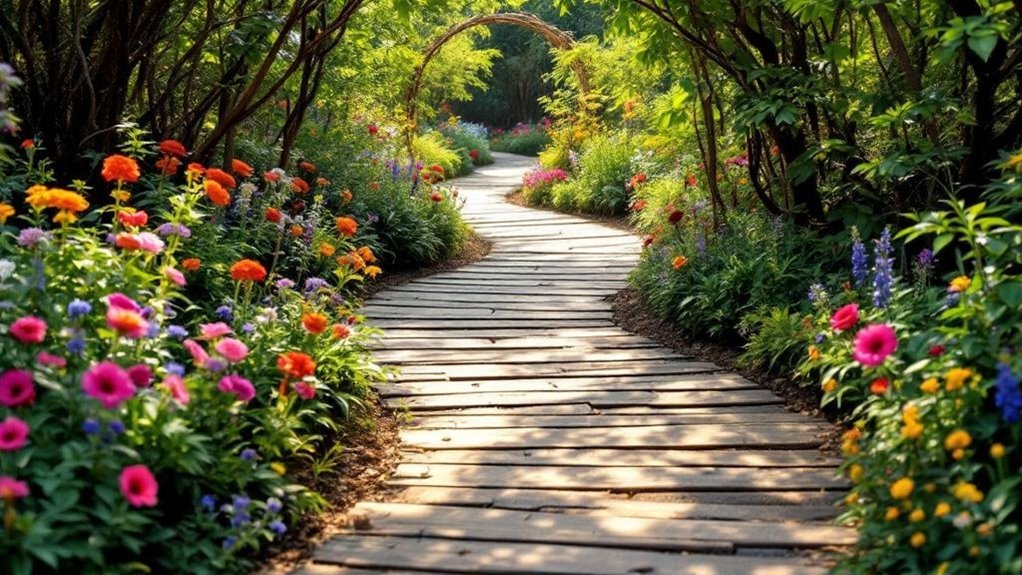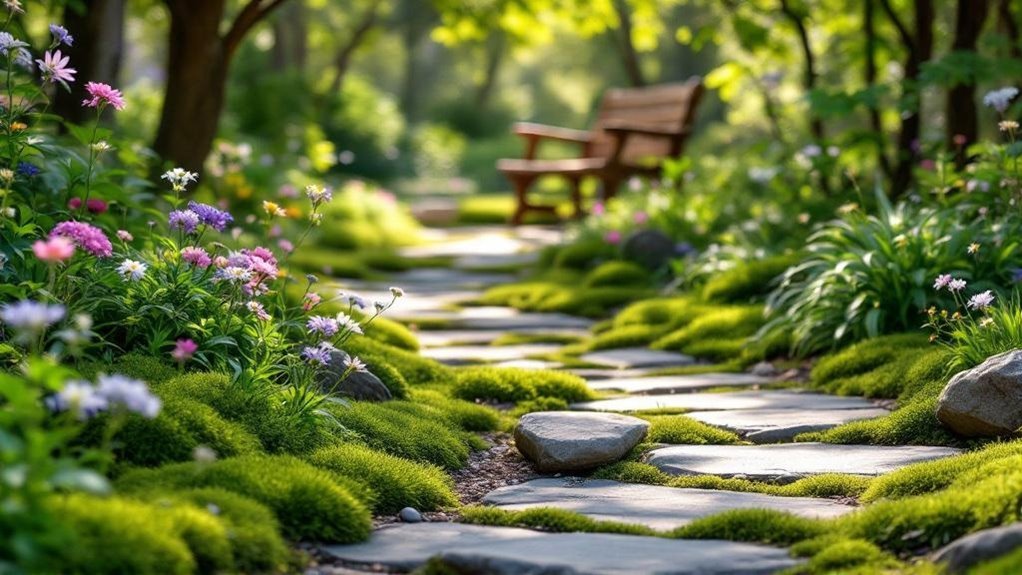When you’re planning natural garden paths, it helps to start by really understanding your yard’s layout and how you move through it. Choosing the right materials and shapes can transform a simple walkway into a stunning feature that feels like part of the landscape. But finding the balance between beauty and function isn’t always straightforward, especially if you want something that lasts and blends seamlessly with your garden’s vibe.
Assessing Your Yard for Pathway Planning
Before you design your garden paths, take a close look at your yard’s size and shape to figure out where pathways can best connect key areas like the front and backyard.
Start by evaluating the grade to spot any slopes or uneven terrain that might need winding routes or steps for safety. Pay attention to existing foot traffic; these natural routes often reveal the most practical spots for your garden pathways.
Incorporate this insight into your overall landscape design to guarantee the paths feel intuitive and functional. By carefully considering these factors, you’ll create a cohesive flow that enhances your yard’s usability and aesthetic appeal without disrupting natural patterns or causing drainage issues.
This thoughtful planning sets a strong foundation for your garden pathways.
Choosing the Right Materials for Natural Paths
When selecting materials for your natural garden paths, it’s important to balance durability with aesthetics to complement your landscape. Choose materials like gravel, stone pavers, or decomposed granite for their natural look and long-lasting quality.
Consider how much foot traffic your garden pathway will see; high-traffic areas need tougher options like stone pavers, while low-traffic spots can handle softer materials. Using locally sourced, eco-friendly materials not only supports sustainability but also blends your path seamlessly into the environment.
Don’t forget drainage—gravel and similar materials help water pass through, preventing puddles and damage. You can also mix materials creatively, such as combining stone pavers with gravel or adding low plants between stones, to make your garden pathway both practical and visually appealing.
Designing Path Shapes and Layouts

Although choosing materials is crucial, designing the shape and layout of your garden paths determines how people experience the space.
Designing your garden path’s shape and layout shapes how visitors engage with your outdoor space.
When planning your pathway, consider these key points:
- Path Shape: Straight paths create a formal feel, while meandering or zigzag designs add spaciousness and safety, especially on slopes.
- Connection & Flow: Identify natural access routes to link garden areas smoothly, enhancing both foot traffic and visual flow.
- Scale & Elevation: Confirm the pathway isn’t too wide or narrow; incorporate steps if needed for elevation changes, and account for seasonal shifts like frost heaving.
Using stones set consistently throughout your garden design reinforces unity, guiding the eye and creating a cohesive, inviting outdoor experience.
Incorporating Plants and Groundcovers Along Paths
Since garden paths guide visitors through your outdoor space, incorporating plants and groundcovers along their edges can enhance both beauty and function.
You can use creeping thyme as a fragrant, soft groundcover that also prevents soil erosion along pathways. Moss works wonderfully in shaded stone gardens, adding a lush, organic touch. Low-growing plants like bugleweed bring seasonal color and suppress weeds effectively.
Lamb’s ears soften hard surfaces with their velvety texture, providing durability and low maintenance. Herbaceous plants such as lavender and rosemary not only enhance sensory experiences through their fragrance but also attract pollinators, enriching your garden’s ecosystem.
Installation Techniques for Natural Garden Paths

Before you start digging, mark your garden path clearly with string or stakes to visualize its shape and assure straight or curved edges.
To create a path that blends naturally, follow these crucial steps:
Follow these essential steps to craft a garden path that harmonizes seamlessly with your outdoor space.
- Dig about 6 inches deep along your marked line, removing grass and debris to form a stable base.
- For a gravel path, lay loose stones at the bottom and tamp them down firmly, then add a sand layer for leveling.
- When using stepping stones, space them evenly and set each securely on a sand base to prevent shifting.
These garden path ideas guarantee durability and aesthetic appeal, helping you craft a path that enhances your outdoor space beautifully.
Enhancing Paths With Edging and Decorative Elements
When you add edging and decorative touches to your garden paths, you not only define their shape but also elevate the entire outdoor space.
Choose edging materials like bricks, stones, or metal strips to keep your path tidy and enhance the aesthetic with a polished look. Incorporate decorative elements such as solar lights to add ambiance and improve nighttime visibility.
Planting lavender or ornamental grasses along the edges softens hard lines and introduces fragrance and movement, boosting sensory appeal. Scatter decorative stones or pebbles within the edging to create visual interest and contrast, making your path more inviting.
Finally, consider placing small benches or sculptures at key spots to serve as focal points, encouraging exploration and enriching your garden’s charm.
Maintaining Safety and Durability in Outdoor Walkways
Although outdoor walkways add charm to your garden, maintaining their safety and durability requires careful material choices and regular upkeep.
Outdoor walkways enhance garden beauty but demand thoughtful materials and consistent care for lasting safety.
To keep your paths safe and durable, focus on these key aspects:
- Choose non-slippery, durable materials like textured pavers, gravel, or decomposed granite to prevent slips, especially when wet.
- Guarantee proper drainage by sloping paths or installing drainage grates to avoid standing water that can damage materials and create hazards.
- Commit to regular maintenance by clearing debris, removing algae, and repairing wear and tear to uphold safety and longevity.
Creative Ideas for Mixing Materials in Path Design
Ensuring your garden paths are safe and durable sets a strong foundation for exploring creative design options. Mixing stone, gravel or crushed materials, and decomposed granite can elevate both function and style. For example, combining flagstone with decomposed granite fills gaps and polishes the surface. Contrasting textures like smooth pavers alongside rough gravel add visual interest. You can even try a checkerboard pattern of brick and pea gravel for a playful touch. Here’s a quick guide:
| Material Combination | Benefits | Visual Effect |
|---|---|---|
| Flagstone + Decomposed Granite | Stability + polished finish | Natural elegance |
| Smooth Pavers + Gravel | Texture contrast + guidance | Dynamic path flow |
| Brick + Pea Gravel | Durability + drainage | Playful checkerboard |
| Stepping Stones + Mulch | Soft footfall + natural blend | Harmonious garden |
Mix materials thoughtfully to create unique garden paths that last.
Using Focal Points to Guide and Beautify Your Pathways
Focal points bring your garden paths to life by creating visual destinations that draw the eye and invite exploration.
Focal points enliven garden paths, guiding the eye and inspiring a sense of discovery.
When you use focal points along your pathway, you transform your outdoor space into an engaging journey. Here’s how to use them effectively:
- Place a statue, decorative bench, or unique art piece as a visual anchor at the end of the path to establish a clear destination.
- Position interesting plants or smaller art pieces along the way to encourage visitors to explore further.
- Create seating areas near focal points so guests can relax and fully appreciate the garden’s design.
Frequently Asked Questions
How Can I Make My Garden Path Look Better?
You can improve your garden path by mixing materials like flagstone and gravel, adding edging to keep it neat, planting groundcovers between stones, installing solar lights for ambiance, and placing a focal point like a bench at the end.
How to Create a Natural Garden Path?
Imagine you’re guiding friends through a shady backyard with flagstone steps nestled in moss. To create your own natural path, choose materials matching your soil, plan routes connecting garden spots, and plant groundcovers for a soft, inviting look.
What Is the Cheapest Way to Build a Walkway?
You’ll find mulch pathways the cheapest, costing about $1 per square foot. Just lay landscape fabric, spread mulch, and you’re set. Using reclaimed bricks or stones also saves money and adds unique charm to your walkway.
What Is the Cheapest Way to Make a Garden Path?
You’ll find mulch pathways the cheapest to make. Just mark, dig soil, lay landscape fabric, and add mulch. It’s affordable, simple, and natural-looking. Pea gravel and grass paths are also budget-friendly options you can try.
Final Thoughts
Now that you’ve got the basics down, why settle for ordinary when your garden paths can be natural masterpieces? By thoughtfully planning, choosing the right materials, and adding creative touches like plants and lighting, you’ll craft inviting walkways that blend seamlessly with your landscape. Remember, a beautiful garden path isn’t just about function—it’s about creating a journey worth taking. Ready to transform your outdoor space into something truly special?
